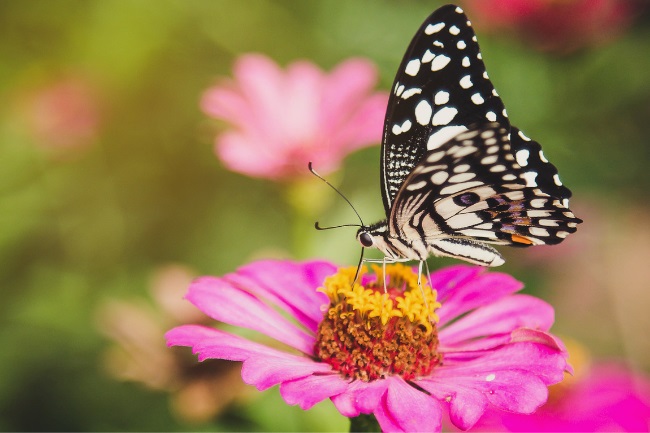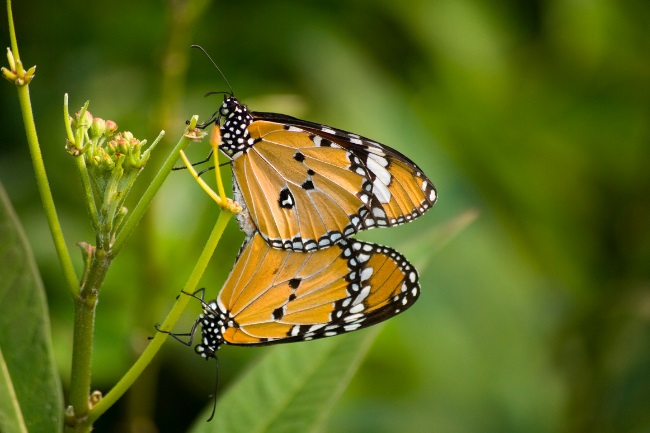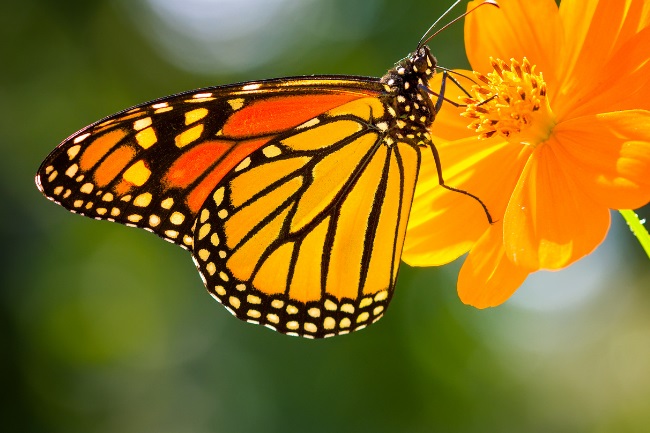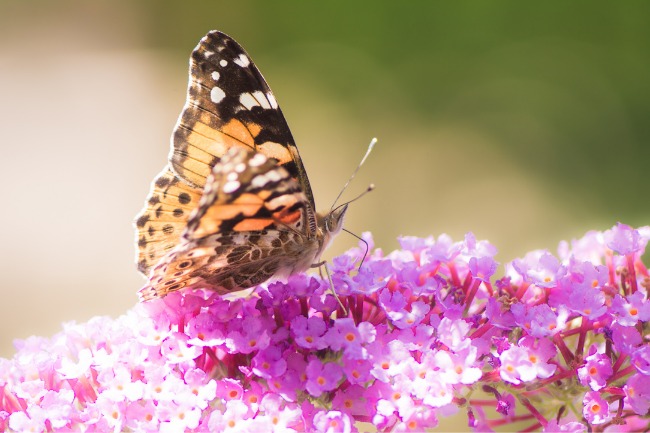Many species of the butterfly do migrate, such as the monarch butterfly and the painted lady. This is usually to escape poor conditions or find additional sources of food.
Contents
Why do animals migrate?
While humans spend their time drawing lines on maps and building up barriers, our animal friends are much more free in how they live. Whether it be the caribou in the arctic, or swallows in Africa, many species spend their lives moving between different places, countries and habitats.
There are many reasons why animals choose to migrate. Usually this behaviour has evolved to help improve their chances of survival. Common reasons for migration are; to find or follow a food source, to reach breeding grounds or to avoid poor weather conditions.
Also read: Here’s How and What Does a Butterfly Eat in The Winter
Finding a Food Source

Many food sources are highly seasonal. This means for some species there are times of year when food is plentiful and times when it is scarce. During the times of scarcity, large numbers of animals can die from hunger, particularly youngsters who are less experienced in finding food.
To avoid this harsh reality many species migrate to pastures new, where food is more likely to be plentiful. Wildebeest, for example, follow the rain to where there will be fresh grass growing. Others may follow seasons so that they can arrive at each new location just as their food source is becoming available.
Also read: What do Butterflies Eat and Drink? (Detailed Guide)
Reaching a breeding ground

The perfect breeding ground for many animals is one where predators are scarce. For this reason, some bird species migrate to the arctic or antarctic in the summer, as few predators are able to survive the harsh winters there.
Other species aim to be where the food is at its most plentiful, to ensure they can feed up their young quickly. Whatever the strategy it is often the case that specific breeding grounds are travelled many thousands of miles to, being worth the long journey to be able to produce healthy young.
Avoiding poor weather
Within temperate climates the shifting of the seasons from hot to cold can have a disastrous effect on the amount of food available. Cold winter conditions also take more energy to survive, and can lead to high winter mortality.
Many birds migrate south during the winter, seeking out warmer weather and more comfortable life in areas that are not reached by the frost. Despite the treacherous nature of the journey, the risk is often worth it compared to staying behind.
Also read: Hummingbirds During the Winter… Migration Explained
What butterfly species migrate?
| Butterfly Species | Migration Behavior |
|---|---|
| Monarch Butterfly | Long-distance migration spanning thousands of miles |
| Painted Lady Butterfly | Long-distance migration, but varies in different regions |
| Red Admiral Butterfly | Moderate-distance migration across regions |
| Clouded Yellow Butterfly | Long-distance migration in Europe and North Africa |
| Common Buckeye Butterfly | Short to moderate-distance migration in North America |
The Monarch butterfly

The Monarch butterfly is the most famous of the world’s migrating insects. This butterfly is native to North and South America, though today it is found across the world. There are two species within North America, the Western and the Eastern Monarch butterflies.
The Eastern Monarch are found across the Eastern states up to Canada, while the Western Monarch breeds in the Rocky mountains. The young of the monarch butterfly feed on milkweeds, which is where the adults lay their eggs.
Once the eggs have hatched they either stay put if the weather is still fine or, if they hatch at the end of the summer, they will undertake their long trek south, where they will go into diapause, a type of hibernation.
For The Eastern Monarch, their trek takes them all the way down to Mexico, which can be a journey of around 3,000 miles. For the Western Monarch, they will head to California. After resting through the cold period these adults awake in the spring ready to head north again, stopping partway to lay their eggs. From here each generation will move a little more northwards before the whole cycle starts again.
This long migration is impressive for a little butterfly, but no monarch completes the entire journey, needing several generations to complete it. This is not unusual for insects, who often have too short a lifespan to complete a full cycle. This way they get the advantage of the migration between generations instead of at one particular point.
For monarchs, their reason for migrating is largely to do with avoiding the cold weather, as winter threatens to set in, but it also allows them to follow their food, the milkweed, as it appears in the spring and summer.
Also read: Creating a DIY Butterfly Garden (A List of Must-Haves)
The Painted Lady

Though not quite as famous as the monarch butterfly, the painted lady is in many ways its European/African equivalent. This tiny butterfly spends its time migrating from the tropical climes of Africa to the Arctic circle, a trip of 9,000 miles.
Like the monarch butterfly, it does not undertake the whole trip in one go but moves generationally between its two endpoints. Its arrival in the UK is often found to be highly variable between years and for a long time people believed it arrived only to die as the winter set in. However, new research shows that this butterfly climes up to 500m into the air and uses favourable winds to move it at over 30mph back towards its place of origin in Africa.
These plucky little butterflies have been found to travel over 5,000 miles in a single generation, and are even brave enough to cross the Sahara desert.
Little butterflies with big dreams
While the long journeys undertaken by animals may seem unbelievable to us, to butterflies, birds and beasts they are just a part of life. When there is no benefit to staying always in one place, and every benefit in moving, then why stay put? After all when winter’s coming, why not head out for a little bit of sun?
| Butterfly Species | Migration Routes |
|---|---|
| Monarch Butterfly | North America to Mexico and back, or from North America to California and back |
| Painted Lady Butterfly | Varies by region; examples include North America to Mexico and North Africa to Europe |
| Red Admiral Butterfly | Varies by region; examples include Europe to North Africa and North America |
| Clouded Yellow Butterfly | Europe to North Africa and back |
| Common Buckeye Butterfly | Varies by region; examples include North America to southern United States |
| Butterfly Species | Reasons for Migration |
|---|---|
| Monarch Butterfly | Escape harsh winter conditions, find suitable breeding habitats, access to food sources |
| Painted Lady Butterfly | Escape unfavorable environmental conditions, locate food and breeding sites, take advantage of resources |
| Red Admiral Butterfly | Escape cold winters, find suitable breeding areas, access to food sources |
| Clouded Yellow Butterfly | Escape cold climates, find suitable breeding and feeding grounds |
| Common Buckeye Butterfly | Avoid cold winters, find favorable climate and food resources |
FAQ
How do butterflies migrate?
The answer to how butterflies migrate is surprisingly variable. Researchers have found that various species navigate by the sun, moon and stars, through the use of the sun’s polarised light, and even navigating using landmarks such as coastlines.
It is amazing to think that these tiny creatures can be so sure of their destination when previous generations who came before them are no longer there to guide them.
Also read: Do Dragonflies Migrate or Hibernate? (Surviving Winter)
Do queen butterflies migrate?
Queen butterflies are similar to monarchs, and like monarch butterflies, they too migrate, but their migration is smaller as they spend their time in warmer climates.
What butterfly migrates from Canada to Mexico?
The monarch butterfly is the most famous species to migrate all the way from Canada to Mexico.

